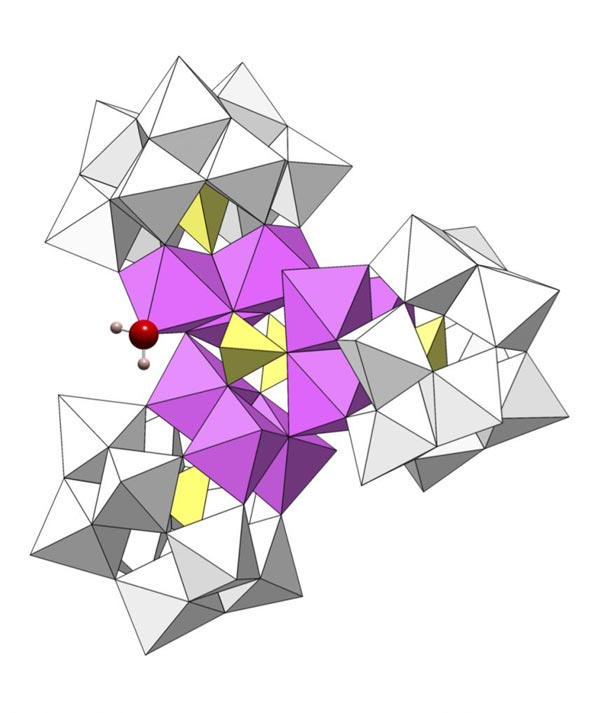Cobalt and tungsten — the key to cheaper, cleaner hydrogen

The new catalyst 'splits' water molecules to obtain hydrogen and oxygen with very low voltages. Credit: ICIQ
Electrolysis, splitting the water molecule with electricity, is the cleanest way to obtain hydrogen, a clean and renewable fuel. Now, researchers at ICIQ and URV, led by Prof. José Ramón Galán-Mascarós, designed a new catalyst that reduces the cost of electrolytic hydrogen production. Catalysts reduce the amount of electricity needed to break the chemical bonds, speed up the reaction and minimise the energy waste.
'Normally, hydrogen is obtained from using a cheap process called steam reforming. But this is not clean hydrogen, this process uses natural gas and produces carbon dioxide and other contaminants,' explains Galán-Mascarós. 'Breaking the water molecule is cleaner, but it's not easy. We need to develop new cheap, efficient catalysts that allow us to obtain hydrogen at a competitive price,' he says. To date, the best catalysts are based in iridium oxides, but iridium is a very expensive and scarce precious metal.
Chemists at ICIQ and URV discovered a compound made of cobalt and tungsten -technically called a polyoxometalate- which can catalyse water splitting better than iridium. 'Polyoxometalates are nanometric molecular oxides that combine the best of two worlds, the great activity of oxides and the versatility of molecules,' explains Marta Blasco-Ahicart, postdoctoral researcher at ICIQ and first author of the Nature Chemistry paper.
'Our polyoxometalates are way cheaper than iridium and allow us to work in acidic media, the optimal media to generate oxygen that is normally a drawback for catalysts, which are usually consumed by the acid,' clarifies Blasco-Ahicart.
Joaquín Soriano, co-author of the paper and currently a postdoctoral researcher at Trinity College in Dublin, explains that 'our catalysts work specially well when we work with low voltajes.' 'That may seem an issue' -he explains- 'but is rather an advantage, it saves electricity and will allow us, soon, to obtain the energy required for water splitting from renewable sources like solar panels.'
Moreover, researchers present in their paper an additional discovery. Supporting the catalysts in a partially hydrophobic -water repellent- material, the efficiency of the process improves. This generates a 'waterproof' reactor where electrolysis advances quicker, and also enhances the lifetime of catalysts.
The new methodology not only improves the performance of the new cobalt-tungsten polyoxometalates, but also with a lot of different catalytic systems. Nowadays, researchers are investigating new ways of taking advantage of this new finding, developing new hydrophobic scaffolds to further boost the efficiency of water splitting, a fundamental step towards the evolution of artificial photosynthesis.
Media Contact
All latest news from the category: Life Sciences and Chemistry
Articles and reports from the Life Sciences and chemistry area deal with applied and basic research into modern biology, chemistry and human medicine.
Valuable information can be found on a range of life sciences fields including bacteriology, biochemistry, bionics, bioinformatics, biophysics, biotechnology, genetics, geobotany, human biology, marine biology, microbiology, molecular biology, cellular biology, zoology, bioinorganic chemistry, microchemistry and environmental chemistry.
Newest articles

Innovative vortex beam technology
…unleashes ultra-secure, high-capacity data transmission. Scientists have developed a breakthrough optical technology that could dramatically enhance the capacity and security of data transmission (Fig. 1). By utilizing a new type…

Tiny dancers: Scientists synchronise bacterial motion
Researchers at TU Delft have discovered that E. coli bacteria can synchronise their movements, creating order in seemingly random biological systems. By trapping individual bacteria in micro-engineered circular cavities and…

Primary investigation on ram-rotor detonation engine
Detonation is a supersonic combustion wave, characterized by a shock wave driven by the energy release from closely coupled chemical reactions. It is a typical form of pressure gain combustion,…



